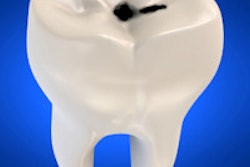
In part one of this series, John Frachella, DMD, looked at the history of using silver nitrate and silver fluoride for pediatric caries treatment. In the conclusion, he looks at the larger treatment issues and public health concerns.
 John Frachella, DMD.
John Frachella, DMD.This month, Delta Dental released the results of a new survey to raise awareness about the importance of oral health in children. It found relatively poor oral care behavior in children younger than 12 years old. Specifically, the survey found that "only 28% of U.S. parents would give their children an A grade for oral health." Additionally, the survey found that "over 30% of the children did not brush twice a day and over 60% did not floss on a daily basis."
Coincidentally, an increasing numbers of parents, teachers, and school nurses are understandably concerned about kids running around with toothaches, while, at the same time, fewer dentists want to take on new Medicaid patients. Waiting until there's enough time in someone's appointment book, or until a child grows up or new dentists open their doors to children on welfare, should not be accepted by dental professionals or patients.
If we dentists used silver solutions on kids' decayed teeth, we could treat more children in less time, painlessly, and at less expense. It's not that silver is the only way to address extensive tooth decay, but it can help, especially when used along with what's already available. Silver solutions can be used first to stop infection, then drilling and filling can be done later when time, money, or behavior permits. It's that easy. Using silver solutions has the potential to correct some of the shortfalls in our healthcare delivery system (which needs as much help as it can get). Consumer demand can assist in correcting those shortfalls as much as anything.
“Silver solutions can be used first to stop infection, then drilling and filling can be done later.”
Take, for example, the case of invisible braces, which were initially shunned by most orthodontists. The public demanded them and today dental patients of all ages are wearing invisible braces. The same thing happened with independent hygiene practices. Today, you can have your teeth cleaned as easily as getting a haircut, despite vigorous opposition by dentists.
The application of silver solutions to teeth will go the same route. Parents will force the change. After all, do you want your kid's teeth drilled and filled one decayed molar at a time at the eventual cost of a good used car, or do you want the infection stopped now, painlessly and for the lowest possible cost?
Tax dollars
OK, maybe you're saying that you and your kids don't have tooth decay. But how about your tax dollars spent being on public health dental programs whether you approve of them or not? Public dental programs simply can't afford the high cost of keeping up with the growth of the epidemic. States are hurting:
- Texas: Federal auditors say that hundreds of millions of dollars were spent on unnecessary dental services in 2014.
- California: A new audit is accusing the state dental program of leaving low-income children at high risk of developing lifelong dental disease and of serving fewer than half of those enrolled.
- Vermont: Swelling Medicaid rolls and low reimbursement rates are impeding dental care due to the Patient Protection and Affordable Care Act's expansion of the Medicaid dental program.
- Pennsylvania: Medicaid reform advocates decided to fight for dental services for more than 200,000 low-income patients threatened to be cut because the system is going broke.
If you'd like to change that, speak up by embracing the concept of using low-cost silver nitrate and silver fluoride, especially for those children and adults who need it the most.
The other day I had a cute 4-year-old girl in my dental chair for a six-month recall exam. I could see from the darkness on the chewing surfaces of her baby teeth that a silver solution had been applied, then sealed over with a hard, white material commonly used by dentists to slow decay. I commented on the darkness under the white fillings and the child responded indignantly saying that those were her "black diamonds." Of course! The decay had been stopped, and no needles or drills had been used. Who am I to argue with this kid or with her parents if that's what they want for their child?
I'm glad that this little patient does not have active tooth decay, hasn't lost any teeth, remains infection-free, and is proud of her black diamonds. Some day when she matures, I hope I'll make those dark fillings white.
I'm a pediatric dentist with more than 40 years of experience in public and private practices in Maine and Oregon. I'm an educator at Oregon Health Sciences University and have served on staff at numerous hospitals in Maine. My entire career as a public health dentist has been focused on serving the underserved. I know from experience that adding silver solutions to our dental tool kits is a small change that can rapidly reduce the disease burden on children and adults who are in immediate need. Ask for it, so you and your children can receive needed help.
John Frachella, DMD, is the dental director of Asher Community Health Center federally qualified dental clinics in Wheeler County in Oregon. He is also on staff at the Oregon Health Sciences University School of Dentistry.
The comments and observations expressed herein do not necessarily reflect the opinions of DrBicuspid.com, nor should they be construed as an endorsement or admonishment of any particular idea, vendor, or organization.



















